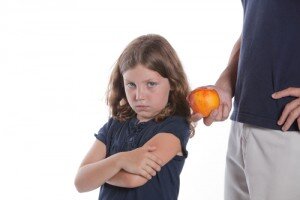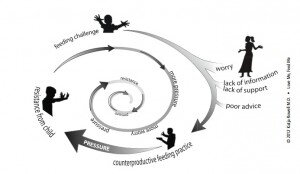Worry Cycle IV: Why Kids Push Back on Pressure with Eating
 This is the last installment for Adoption Month on my introduction to the Worry Cycle. Just in time for Thanksgiving. Maybe at this year's Holiday table you can experiment and see how it feels if you let the worry and pressure go. It might just surprise you!Part I reviews why some children present with feeding challenges, and why it is more common for adopted and foster children to experience difficulties.Part II describes how most parents are simply not well supported or prepared to deal with feeding challenges, and most egregiously, when the very experts they turn to for help give bad advice.Part III reviews ways that parents try to help children eat well, whether the goal is to get the child to eat more, less or different foods. Here is a summary of the most common culprits I see:
This is the last installment for Adoption Month on my introduction to the Worry Cycle. Just in time for Thanksgiving. Maybe at this year's Holiday table you can experiment and see how it feels if you let the worry and pressure go. It might just surprise you!Part I reviews why some children present with feeding challenges, and why it is more common for adopted and foster children to experience difficulties.Part II describes how most parents are simply not well supported or prepared to deal with feeding challenges, and most egregiously, when the very experts they turn to for help give bad advice.Part III reviews ways that parents try to help children eat well, whether the goal is to get the child to eat more, less or different foods. Here is a summary of the most common culprits I see:
- Bribes: “You can have dessert if you eat two bites of chicken.”
- Pressure: “You have to eat two bites of everything on your plate,” or “You have to take a “no-thank-you bite.”
- Negotiating:“Okay,two bites of this, then one bite of that. No? Three small bites of this one then...”
- Catering with cooking: “I made you rice, look! You don’t want rice? Want some buttered noodles instead?”
- Guilt: “You are so lucky you got adopted; think of all the children who don’t have this wonderful food,” or “It shows Mommy we love her when we eat the food she makes.”
- Begging: “Please, just take at least one bite. Please, please, please.”
- Forcing: Physically placing or forcing food into a child’s mouth or holding a child’s head or hands while feeding.
“‘Just make them eat.’—that one gets me every time!”— Sherry, mother of a five-year-old selective eater
Which brings us to the child and Part IV of the worry cycle. Why kids push back against counterproductive feeding practices, and why all the effort usually makes things worse.Don't forget, the good news is you don't have to work so hard...
Why kids push back against counterproductive feeding practices, and why all the effort usually makes things worse.Don't forget, the good news is you don't have to work so hard...
Stress and mealtime battles make it hard for children to tune in to hunger and fullness cues coming from their own bodies and makes it more likely they will eat more or less than they otherwise would.
Another anxious parent told me: “But we don’t pressure, we praise and encourage. That’s what we were told to do.” Pressure sounds negative, like “push,” “force,” or “threaten.” Many parents don’t pressure in these negative ways, but they still pressure. Praising Bobby for trying a new food can feel like pressure to Bobby. Giving Suzy a sticker or a toy for eating her veggies is pressure. Clapping wildly and commenting about how brave Timmy is to try a food may feel like pressure to Timmy. Going on about the nutritional benefits and how it will make him strong is also pressure. Don’t forget, if you are locked in a power struggle over food and you make a big deal of Bobby eating a piece of broccoli, you have now handed him control. He has a little green power chip.
A little more about “positive” pressure: what kids might think
- “Hmm, Mom really cares about me eating broccoli, and I want to annoy Mom.” (You see where this is going.)
- The persistent or independent child who wants it to be his idea; he wants to be in control and may feel robbed of that feeling if he is encouraged or praised.
- “This stuff must taste really bad if I need a reward to eat it.”
- “They must not think I can do this if they are buying me a present.”
- “Will they love me if I don’t eat this tomorrow?”
Iris' A-ha moment
Iris homeschools her two daughters: Ali, her biological daughter, and her youngest, Bea, who is thriving in an open, transracial adoption. Iris notes that with their schoolwork, Ali shuts down completely with any praise or direction, while Bea responds to some direction and is more eager to please adults. When she connected their learning styles to their eating, she says it was eye opening. “I realized we had been subtly trying to get Ali to eat more foods. We knew outright pressure didn’t work, so we tried games, talking up the nutrition, or praising when she tried something. Like with her schoolwork, any attempt to steer Ali toward something backfired. Bea, on the other hand, enjoys food and is more easily encouraged, but that can be a downside, too. She might finish her plate to please an adult rather than listen to her body.” Some kids push back a little, some kids push back a lot, some kids don't push back at all.
- Children pressured to eat more tend to eat less, and don’t grow to their potential.
- Pressure leads to stress, which kills appetite
- Stress makes it harder for a child to tune in to cues from their bodies about hunger and fullness.
- Pressure and stress lead children to seek out and rely on safe and comfortable foods.
- Children pressured to eat more fruits and vegetables tend to eat fewer.
What ways does your child push back? Tears, dramatic refusals, raging for hours, not eating, stealing forbidden foods?
Don't forget, for every Love Me, Feed Me book sold for November, National Adoption Month, I will donate $1 to the SPOON foundation. There is still time, get that Holiday shopping done early!
Some of the content of this post is adapted from the book...
